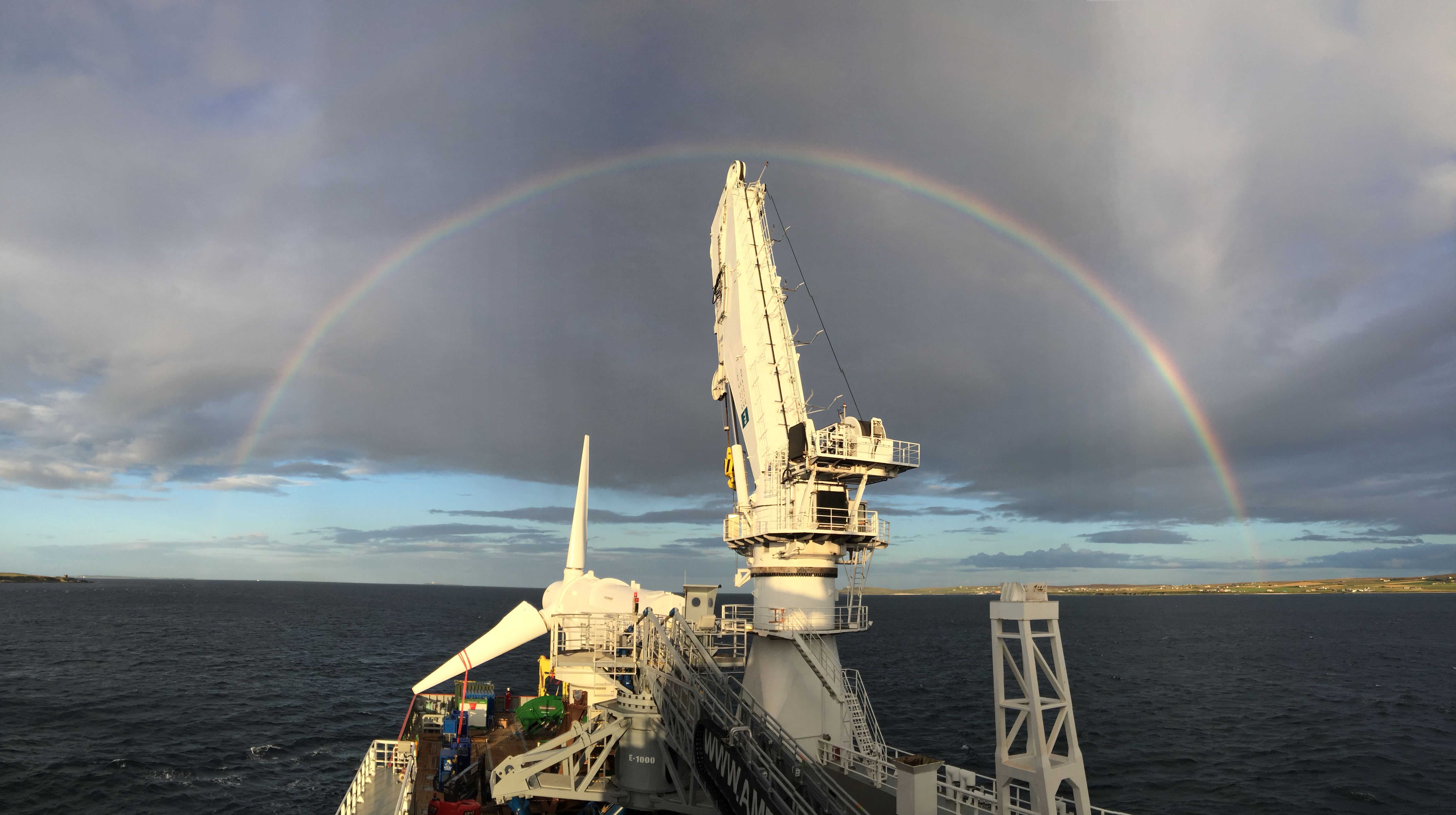
Atlantis Resources’ 6MW tidal array entered its 25 year operational phase in April, a major milestone for the Pentland Firth MayGen project.
To date it has clocked up more than 6GWh and is breaking world records for tidal generation. The baseline may be low, but CEO Tim Cornelius channels Canute with his belief in the inexorable rise of tidal power.
The only question in his mind is whether it is developed in the UK or overseas, though the answer need not be binary.
French intent
France is preparing for a commercial tender in the waters off Normandy and Brittany. Atlantis submitted proposals to the French government this week, suggesting that 1GW could be delivered by 2025 “at a blended price that would be competitive with offshore wind tenders”, according to Cornelius.
That sounds optimistic, given the company bid £150/MWh in the contracts for difference (CfD) auction last September, but Cornelius begs to differ.
“It is aggressive, but not particularly optimistic. It is halving last year’s CfD bid through relatively simple things,” he says.
Cost curve
“Going to multiple turbines per export cable materially reduces construction time and cost. Bigger turbines [the company aims to double the turbine size to 3MW] means greater output impact, because water is 800 times denser than air.
“We are also moving towards more synchronous generation, so won’t need as much power conversion equipment,” says Cornelius. “So there are a multiple elements that lead to cost reduction.”
Crucially, he says tidal power can “ride the coattails” of the offshore wind sector, which is rapidly cutting supply chain costs, with gains in foundations, cabling and construction vessels all applicable to tidal power.
Moreover, Cornelius believes the pivot away from fossil fuels has begun in earnest.
“I would challenge you to find a large utility anywhere in Europe that is not making noises about becoming more renewable than hydrocarbon focused,” he says.
“But more important is oil and gas. They are talking about making colossal investments in the things they understand, which is the offshore environment.”
That expertise will be key to unlocking marine power, says Cornelius, countering arguments that the seabed is simply too harsh an environment for power generation.
“We would argue to the contrary. [UK] offshore oil and gas is only 50-years old, yet it is now considered mature. We are borrowing oil and gas knowhow. We broke the record for installing a turbine in under 60 minutes. So I would argue it is not that challenging an environment. The challenge is more about bringing down the price so that tidal power can compete with thermal generation,” says Cornelius.
“If we were the same price as CCGTs, right now there would be 5GW installed, simple as that.”
Mutual benefits?
Tidal power is nowhere near cost comparable to large thermal plant. Yet UK power market economics are such that even CCGT developers are unwilling to build a mature, relatively straightforward form of generation at present without government support.
But Cornelius says if the French government backs its proposals, both the UK and France will benefit from lower tidal power costs. “It would give us the economies of scale to bid into the [UK] CfD auction much more aggressively,” said Cornelius.
How aggressively?
“Somewhere between the clearing price of the last one, £57.50, and Hinkley C [£92.50 plus inflation]. “
How confident is Atlantis that the French government will back its plans?
“We have to be careful in what we say, but are very confident that they are supportive of what we are doing. They are sitting on a fabulous asset and have a strong history in supporting tidal power. The prime minister [Édouard Philippe] is a former mayor of Le Havre and it would be hugely positive economically for that area, where we receive unbelievable support from local government,” says Cornelius.
“So we are quietly confident that we will get good support.”
UK plans
In the UK, Cornelius says Atlantis has “392MW consented [via MayGen] that could be done tomorrow with a CfD,” and believes with additional permitting the company could potentially develop up to 1.5GW.
Cornelius says MayGen is “fully consented to participate in the 2019 CfD auction” and “understands the need to be competitive”, though believes it is “slightly unfair to have to compete against offshore wind”.
Alongside the auction, the company continues to push for a bilateral CfD, or similar construct, “just some basic inventive to stimulate build up,” says Cornelius. “It would be a shame to see the pipeline built out entirely overseas when it has been developed in the UK.”
The government of 2013 awarded a bilateral CfD to enable EDF to make a final investment decision on Hinkley C. Could tidal power reach gigawatt scale before new nuclear is commissioned?
“With a very modest amount of support, the answer is yes,” says Cornelius.
Wyre power, firepower
Other tidal developers are also lobbying hard for subsidies, with the firm behind the Swansea tidal lagoon warning it will lay off staff if support is not soon forthcoming.
Atlantis owner Simec has an interest in the Swansea project, but Atlantis has outlined its own plans for a tidal barrage, a 160MW project in the Wyre estuary, which it touts as “the pathfinder to bigger projects”.
Cornelius says it is a “very sensible” project that would cost “a couple of hundred million” in capital expenditure. He is convinced – while stressing it is a personal view and not necessarily the opinion of the company’s board or management – that the Wyre project will go ahead.
Moreover, the company’s recent reverse takeover by Simec, part of the GFG Alliance owned by Sanjeev Gupta, means it has a “big brother coming in … a billionaire partner with balance sheet, gravitas and firepower,” says Cornelius. “The last six months of accelerated success is very much due to their involvement.”
By aligning that firepower with the clean growth plans of both the UK and French governments, plus others around the world, Cornelius suggests the tide will turn.
“If governments are willing, industry is ready to deliver.”
Related stories:
Atlantis 6MW tidal array enters commercial operation
Atlantis plans 160MW Wyre tidal barrage
Scotland sets world record for tidal power
Atlantis predicts big year for tidal power
Engineers tell government to pay for tidal power
Government confirms support rates for offshore wind, wave and tidal power
Tidal energy firms clocks up 1GWh, seeks more funds
Follow us at @EnergystMedia. For regular bulletins, sign up for the free newsletter.




“…Other tidal developers are also lobbying hard for subsidies, with the firm behind the Swansea tidal lagoon warning it will lay off staff if support is not soon forthcoming…”
As a retired engineer, I have much sympathy with lay-offs of engineers and technicians, but not with the misguided ‘brains’ behind yet another resource-wasting and expensive renewables technology.
320 MW Swanseas TL will have a capacity factor of 19.6%, a lifespan of 120 years and a capital cost of £1,300 million; every year, it will generate 550,000 MWh of grid-degrading, intermittent electricity.
3,200 MW Hinkley Point C nuclear power plant will have a capacity factor of 90% and a capital cost of £18,000 million; every year it will generate 25,228,800 MW of grid-friendly, 24/7 electricity.
It would take nearly 46 Swansea Lagoons or pumped storage lagoons to generate the same amount of electricity every year at a cost of £59,632 million – that’s against £36,000 million for Hinkley to be built a 2nd time for 120 years of generation.
It is insane to contemplate paying two thirds more for a pathetic intermittent product and desecrating so much of our beautiful coastline and such staggering areas of near-shore sea bed. On top of that, phenomenal quantities of rock would have to be quarried, with the attendant environmental degradation and destruction of ecosystems and species, and huge amounts of GHG emitting cement manufactured, transported and turned into concrete.
The fluffy-cloud world of ‘free-energy’ from Mother Nature’s bountiful resources, must not be allowed to strike yet again!
The 1.5 MW size of turbine, operating at about 32.5% capacity factor will generate 4,270 MWh of intermittent electricity every year, for its 25 year lifespan. It would take 5,900 of these turbines to generate 7% of the UK’s electricity demand every year – albeit of the intermittent variety. The turbines alone weigh in at 200 tonnes each of solid metal – and that’s not counting the metals involved in anchoring it to the sea bed. 5,900 of them would use up 1.18 million tonne of metal.
A 3,200 MW nuclear power plant can generate 7% of the UK’s annual electricity demand – in the 24/7 form – for its 60 year design life, using 141,806 tonne of metals.
Those 5,900 turbines would have to be built a 2nd time and be 10 years into the 3rd build before 60 years of generation was met – that’s a factor of X2.4 and a total metal use of 2.832 million tonne of metal.
In the turbines alone, power from tidal arrays will use 20X more metals, to deliver grid-degrading, intermittent electricity, than the grid-friendly, 24/7 electricity generated by a nuclear power plant.
True environmentalists really should sit back and consider not just the direct, sea-bed environmental consequences of this wasteful use of valuable resources, but also the environmental damage wrought and energy used in quarrying, mining, transport, processing, manufacture and installation.
Sea life has troubles enough already. By the time a PROPER evaluation of the environmental impact of that much tidal power apparatus was completed, we could have enough Gen IV reactors proven and built to power Britain and replace every wind turbine plaguing Ireland as well, exporting the energy.
http://www.bbc.com/news/uk-northern-ireland-35416282
“Jan 27, 2016 – Strangford tidal energy turbine to be removed. A tidal energy turbine installed in Strangford Lough, County Down, is to be removed. The SeaGen turbine was lowered into place in 2008 and generates electricity from from tidal currents.”
It is said to have been an R&D project. This is an exceptionally good location, which means that the performance data will tend to be higher than can be expected in most other locations.